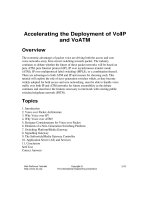Tài liệu Accelerating the Deployment of VoIP and VoATM pdf
Bạn đang xem bản rút gọn của tài liệu. Xem và tải ngay bản đầy đủ của tài liệu tại đây (165.88 KB, 21 trang )
Accelerating the Deployment of VoIP
and VoATM
Overview
The economic advantages of packet voice are driving both the access and core
voice networks away from circuit switching towards packet. The industry
continues to debate whether the future of these packet networks will be based on
pure ATM, pure Internet protocol (IP), IP over asynchronous transfer mode
(ATM), IP over multiprotocol label switching (MPLS), or a combination thereof.
There are advantages to both ATM and IP and reasons for choosing each. This
tutorial will explore the role of next-generation switches which, as they become
widely adopted for both access and core networking, must be able to handle voice
traffic over both IP and ATM networks for future extensibility as the debate
continues and must have the features necessary to interwork with existing public
switched telephone network (PSTN).
Topics
1. Introduction
2. Voice over Packet Architecture
3. Why Voice over IP?
4. Why Voice over ATM?
5. Designer Considerations for Voice over Packet
6. Elements of a Next-Generation Switching Platform
7. Switching Platform/Media Gateway
8. Signalling Gateway
9. The Softswitch/Media Gateway Controller
10. Application Server (AS) and Services
11. Conclusion
Self-Test
Correct Answers
Web ProForum Tutorials
Copyright ©
The International Engineering Consortium
2/21
Glossary
1. Introduction
Carriers are moving voice services to packet networks both to reduce upfront and
operational costs and to provide more value-added services in an increasingly
competitive environment. A recent study by a major carrier found that packet
equipment was 70 percent less expensive than traditional voice equipment, and
data access lines were 60 percent to 80 percent cheaper than voice lines.
Maintenance of packet networks was 50 percent less expensive, while
provisioning was 72 percent lower. However, consolidation of voice from the
PSTN onto packet networks has, in the past, proven difficult and therefore has
happened very slowly. International voice-over–IP call volumes, which provide
the most compelling business case for packet telephony, are still a drop in the
ocean of international telephony traffic but have experienced phenomenal growth
since 1998, according to a recent report by Washington, D.C.–based research
group TeleGeography. According to the "TeleGeography 2001" report, which
contains results of an exclusive survey of major voice-over-packet (VoP)
providers in 1999 and 2000, international Internet telephony traffic volumes
reached 1.7 billion minutes in 1999—a growth rate of more than 1,000 percent
from 1998. IDC projected more than 9 billion minutes of voice traffic to travel
over worldwide packet networks in 2000, exceeding 135 billion minutes in 2004.
Service revenue is projected at $1.6 billion in 2000 and $18.7 billion in 2004.
While it is clear that VoP is growing, there is still considerable debate about
whether the underlying network technology will be ATM or IP. At the edge of the
network the choice, driven primarily by the regional Bell operating companies
(RBOCs), is ATM. An ATM–dominated access network is clearly in the works
because until recently IP did not provide the quality of service (QoS) guarantees
that are so important for voice. Although QoS protocols such as DiffServ,
resource reservation protocol (RSVP), and MPLS have been implemented, most
of today's IP traffic is actually being carried over ATM. However, in the long term
with the recent success of MPLS it appears that pure IP over lambda may be the
winner. And certainly, IP at the application layer and the desktop is a more than
just a viable near-term situation.
In addition to the challenges in architecting networks with end to end QoS,
service providers must ensure that the rollout of such networks cause no
disruption to their existing voice service revenue, which currently represent
about 80 percent of their overall revenue source. With more than $650 billion of
worldwide revenue generated by traditional voice and fax services and more than
$250 billion installed base of traditional equipment infrastructure in the United
States alone, service providers must deploy next-generation packet switches that
seamlessly interconnect and competitively function as time division multiplexing
Web ProForum Tutorials
Copyright ©
The International Engineering Consortium
3/21
(TDM)–based PSTN switches as well as support voice over ATM (VoATM) and
voice over IP (VoIP).
It appears that most carriers, especially the larger incumbent carriers will start
the migration to packet telephony on the trunk side first (Class-4 tandem) and
eventually migrate to the access (Class 5). This migration model is similar to the
migration from analog switches to digital switches, which started in the late
1970s. Carriers first started on the inner network (i.e., tandem) and then moved
outwards to the Class 5.
The architecture for VoP, the reasons for choosing IP or ATM, and considerations
in next-generation system design need to be understood to accelerate VoP
deployments.
2. Voice over Packet Architecture
In principle, two basic technologies are used for building high-capacity networks:
circuit switching and packet switching. In circuit-switched networks, network
resources are reserved all the way from sender to receiver before the start of the
transfer, thereby creating a circuit. The resources are dedicated to the circuit
during the whole transfer. Control signaling and payload data transfers are
separated in circuit-switched networks. Processing of control information and
control signaling such as routing is performed mainly at circuit setup and
termination. Consequently, the transfer of payload data within the circuit does
not contain any overhead in the form of headers or the like. Traditional voice
telephone service is an example of circuit switching.
Circuit-Switched Networks
Carrier-class next-generation switches need to be high-capacity fault-tolerant
TDM and VoP switches. They must be designed to significantly enhance the
economics of providing traditional TDM–based voice and data services as well as
help service providers migrate to a packet-based telecom network (based on VoIP
and VoATM) and generate new competitive services. Service providers deploying
next-generation switches can cap their investment in traditional circuit switches
and migrate to a converged switching infrastructure that allows them to reduce
the number of overlay network platforms and provide profitable voice and data
services over packet networks. See Figure 1.
Web ProForum Tutorials
Copyright ©
The International Engineering Consortium
4/21
Figure 1. A High-Capacity TDM Switch Capable of Packet
Switching
Since most of the core packet networks today are ATM–based, but most likely
migrating to IP–based, the most future-proof investment is in next generation
switches that can be deployed to transport voice on both ATM and IP networks
supporting protocol layers as outlined in Figure 2.
Figure 2.
Web ProForum Tutorials
Copyright ©
The International Engineering Consortium
5/21
3. Why Voice over IP?
Support for voice communications using IP, which is usually called VoIP, has
become especially attractive to consumers given the low-cost, flat-rate pricing of
the public Internet.
VoIP is the ability to make telephone calls and access service over IP–based data
networks with a suitable QoS and superior cost/benefit to PSTN–based calls.
Today, most of the VoIP implementations are carried over ATM–based transport
as shown in the second column of Figure 2.
The benefits of implementing VoIP are mostly consumer-based and can be
divided into the following three categories:
• Cost reduction—IP is everywhere. It is on our desktops and it is what
the Internet is based on. Many people view the Internet as a "free
transport" for data and voice services. With the introduction of
Net2Phone and other similar "free" services, many people are now
making phone calls over the Internet. In addition, businesses and
individuals have turned to higher-quality commercial products and
services to make voice calls based on IP. The prevalence of IP nodes
and the abundant supply of better IP–based switches and routers
continue to reduce the cost of providing VoIP.
• Simplification and consolidation—An integrated infrastructure
that supports all forms of communication could allow more
standardization and could reduce the total equipment complement.
The differences between the traffic patterns of voice and data offer
further opportunities for significant efficiency improvements.
Universal use of IP for all applications, voice and data, holds out the
promise of both reduced complexity and more flexibility.
• Advanced applications—Even though basic telephony and facsimile
are the initial applications for VoIP, the longer-term benefits are
expected to be derived from multimedia and multiservice applications.
For example, Internet commerce solutions can combine World Wide
Web access to information with a voice call button that allows
immediate access to a call center agent from a PC. In addition, voice is
an integral part of conferencing systems that could also include shared
screens, white boards, etc. Combining voice and data features into new
applications will provide the greatest returns over the longer term.
Utilizing an IP–based network for voice traffic can offer advantages to consumers
of reduced costs, simplification, and consolidation due to the proliferation of IP–
Web ProForum Tutorials
Copyright ©
The International Engineering Consortium
6/21
based applications and devices at the desktop. These advantages are compelling
for consumers and are driving service providers to consider VoIP
implementations. In contrast, VoP over the ATM–based network offers distinct
advantages directly to service providers and are still much more prevalent today.
4. Why Voice over ATM?
ATM, from the start, was designed to be a multimedia, multiservice technology.
Although ATM has been accepted by service providers for its ability to deliver
high-speed data services, until recently its potential for deploying voice services
was overlooked. With the competitiveness of today's market though, network
operators and service providers have been continuously striving to reduce
operating costs and lift network efficiency and have turned to the ATM network
to achieve these goals.
With hundreds of millions of dollars of ATM equipment infrastructure in the
United States alone, service providers have recognized that significant economies
of scale can be achieved if the data traffic and voice traffic are integrated onto a
single network. In order to achieve this, service providers have started to use the
circuit emulation services (CESs) of ATM switches to carry full or fractional E-
1/T-1 circuits between end points. These CES mechanisms treat voice as a
constant stream of traffic encoded as a constant bit rate (CBR) stream. In
actuality though, voice is a combination of bursts of speech and silence and this
increases the complexity of VoP.
The ATM Forum and International Telecommunications Union (ITU) came up
with several advanced mechanisms to improve the efficiencies of transporting
voice traffic, including:
• ATM trunking using AAL–1 for narrowband services
• ATM trunking using AAL–2 for narrowband services
• IP over ATM (AAL–5)
• Loop emulation service using AAL–2
Web ProForum Tutorials
Copyright ©
The International Engineering Consortium
7/21
Table 1 summarizes the benefits of utilizing the different methods for
transporting VoATM.
Table 1.
Standards
Voice
Compression
Silence
Removal
Channel
Suppression
Switched
Concentration
CES No No No No
BD−CES
No No Yes No
ATM
trunking
using AAL−1
No No Yes Yes
VoIP over
ATM
Yes Yes No No
AAL−2
Yes Yes Yes Yes
5. Design Considerations for Voice over
Packet
Adding voice to packet networks requires an understanding of how to deal with
system level challenges such as interoperability, call control and signaling, voice
encoding, delay, echo, reliability, density, and performance of all the elements
that make up the next-generation switching platform.
6. Elements of a Next-Generation
Switching Platform
The vision for a next-generation switching platform is a distributed architecture
in which media gateway/bearer transport platform, signaling, call control, and
application elements are divided into separate logical network components (see
Figure 3), communicating with one another through the use of intraswitch
protocols such as Megaco, media gateway control protocol (MGCP), and
SCTP/M3UA. This distributed model allows service providers to scale their
network to support hundreds of thousands of subscriber ports per node. In this
concept, voice traffic is directed between the traditional voice network and the
new packet-based networks by the media gateway. The call control is handled by
a softswitch, and the features and services are handled by an application
platform. In reality, the softswitch (or call control platform) may support some of
the more popular services without requiring a separate application platform. An
example of this type of service is 7/10 digit routing, which would be handled
directly by the call control platform. Other examples of where the application
Web ProForum Tutorials
Copyright ©
The International Engineering Consortium
8/21
platform may not be involved are caller name delivery, local number portability
(LNP), and E-800 service. These services are already implemented in the PSTN
using service control points (SCPs). In these cases, the call control platform will
send intelligent network (IN)/transactional capabilities application part (TCAP)
queries over the signaling system 7 (SS7) network to existing SCPs.
Figure 3. Elements of a Next-Generation Switching Platform
Some vendors enable one or more of these logical network elements to be
deployed on the same physical platform. There are some inherent advantages to
this "integrated" model especially with platforms that support up to 100,000
subscriber ports (DS–0s) per bearer platform/media gateway, and allow efficient
execution of the softswitch and signaling gateway software. Benefits also include
cost savings and deployment and operation simplicity. In the "integrated" model,
the need for intraswitch protocols such as Megaco and MGCP are not required;
however interswitch protocols such as RTP/UDP/IP (for MG to MG) and BICC
(for SG to SG) are always required for interoperability with the other ends. See
Figure 4 for relevant inter-switch protocols.









